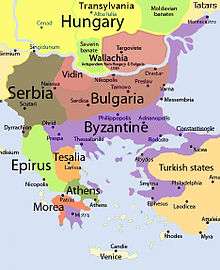Battle of Gallipoli (1312)
The Battle of Gallipoli was fought at the end of 1312[1] or in 1313,[2] between the Byzantines and the Turcopoles (also called Turks) led by Halil Pasha.[1] For two years, Thrace was occupied by Halil Pasha[1] (or Halil Edje).[3] Earlier, Byzantine Emperor Michael IX Palaiologos had raised an army which defeated the Turcopoles, and confined them to a fortified camp in the Gallipoli peninsula.[2] These Turcopoles numbered less than 2,000.[1] Michael next asked assistance from his son-in-law, Serbian King Stefan Milutin, and received a 2,000-strong Serbian cavalry troop (possibly Cumans or Serbian heavy cavalry).[a] Milutin had earlier subdued the Turcopoles that took refuge in Serbia.[2] The Byzantine and Genoese ships completed the blockade,[2] the Genoese preventing the Turcopoles from escaping by sea.[1] The Turcopoles first made unsuccessful attempts at breaking free, but decided to surrender to the Genoese, thinking they would not be harsh.[2] However, in the night, by mistake, many Turcopoles fell into the hands of the Byzantines, who slaughtered them and took their belongings.[2] The Genoese executed only those Turcopoles that had many valuables, so they could not get into the hands of the Byzantines, and the rest they sold as slaves.[4] Halil and his men were all massacred.[1] The Serbian contingent took share in the spoils.[3] The Turcopoles had heavy casualties,[1] with few survivors returning to Byzantine service, though little is heard of them afterwards.[5] The victory was made a poem by Manuel Philes.[4] In two chrysobulls of Andronikos II Palaiologos to the Serbian Hilandar monastery, dating to October 1313 and July 1317, he showed gratitude to Stefan Milutin for his aid, as detailed in the prefaces.[6]
| Battle of Gallipoli (1312) | |||||||
|---|---|---|---|---|---|---|---|
| Part of the Byzantine-Turkish Wars | |||||||
 Map of Bulgaria and Byzantine empire. | |||||||
| |||||||
| Belligerents | |||||||
| Turcopoles |
| ||||||
| Commanders and leaders | |||||||
| Halil † | Novak Grebostrek | ||||||
| Strength | |||||||
| under 2000 |
| ||||||
| Casualties and losses | |||||||
| Heavy, few survivors | Unknown | ||||||
Annotations
- ^ Milutin lent Michael 2,000 cavalry troops.[1][2] According to Danilo II, Archbishop of Serbs (1324–37), these were Milutin's relatives and friends, yet not impossible these cavalry consisted of Cuman warriors.[7] According to American historian Mark Bartusis, these were possibly Cumans earlier lent to the Byzantines,[5] while Hungarian Turkologist István Vásáry mentioned the possibility as well, correlating with later mentions of Cumans in Byzantine service.[7] According to this view, the 2,000 Cumans arrived as allied troops sent by Milutin, then settled the lands and became reserve troops.[7] Greek-Canadian Byzantinist Nikolaos Oikonomides mentions the cavalry as Serbian, as the first of two sent by Milutin.[2]
References
- Nicol 1993, p. 139.
- Oikonomides, p. 164.
- Oikonomides, p. 167.
- Oikonomides, p. 165.
- Bartusis 1997, p. 83.
- Oikonomides, p. 166.
- Vásáry 2005, p. 119.
Sources
- Nicol, Donald M. (14 October 1993). The Last Centuries of Byzantium, 1261-1453. Cambridge University Press. p. 139. ISBN 978-0-521-43991-6.CS1 maint: ref=harv (link)
- Bartusis, Mark C. (1 January 1997). The Late Byzantine Army: Arms and Society, 1204-1453. University of Pennsylvania Press. p. 83. ISBN 0-8122-1620-2.CS1 maint: ref=harv (link)
- Oikonomides, Nicolas. "The Turks in Europe (1305–13) and the Serbs in Asia Minor (1313)" (PDF). The Ottoman Emirate: 159–68. Archived from the original (PDF) on 2016-03-04. Retrieved 2016-01-10.CS1 maint: ref=harv (link)
- Vásáry, István (2005). Cumans and Tatars: Oriental Military in the Pre-Ottoman Balkans, 1185–1365. Cambridge University Press.CS1 maint: ref=harv (link)